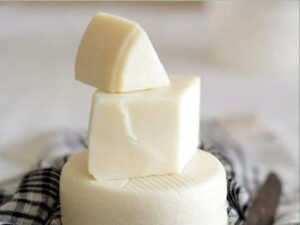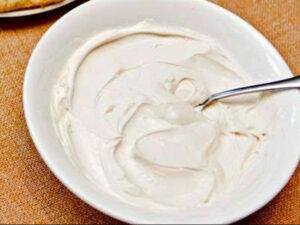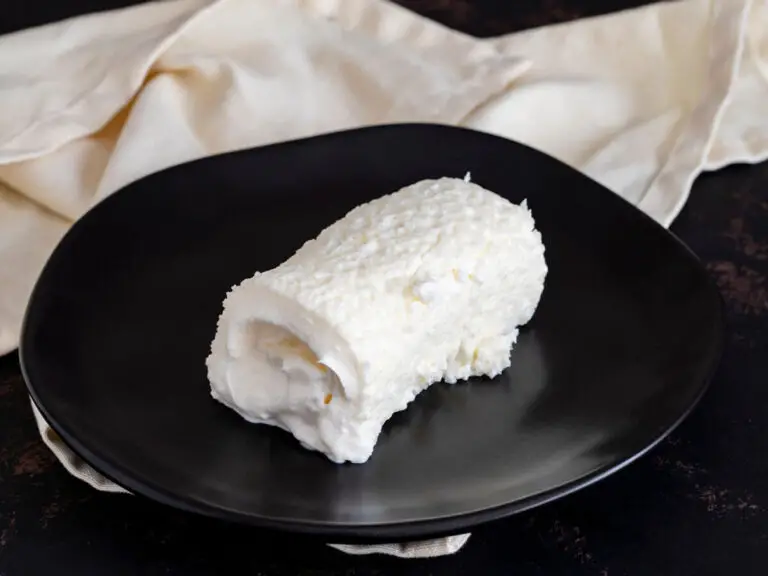Kaymak: Basic Information
Pronunciation
Alternative Name(s)
Dish Type
Course
Mealtime
Popular Variations
Kaymak: Ingredients and Preparation
Main Ingredients
Main Cooking Method
Preparation Process
Kaymak: A Deep Dive
Cultural Significance
Taste
Texture
Aroma
Color
Serving Style
Serving Temperature
Accompaniment
Occasions
Seasons
Special Diets
Calories
Popularity
Popular Similar Dishes
- Clotted Cream
- Malai
- Mascarpone
- Crème Fraîche
- Ricotta
- Clabber
Popular Dining Area
Kaymak is a creamy dairy delicacy made from sheep, goat, cow, or water buffalo milk that resembles clotted cream.
Kaymak originated in Central Asia and is popular in several countries across the Balkans, the Caucasus, the Levant, Turkic regions, Iran, and Iraq.
In Turkey, kaymak is mainly consumed for breakfast as part of the traditional Turkish breakfast. It’s also eaten with baklava, other desserts, fruit preserves, honey, or as a filling in pancakes.
Kaymak holds cultural significance in many regions. For instance, in Turkey, shops have been devoted to its production and consumption for centuries.
In the Balkans, it’s enjoyed as an appetizer or for Saturday morning breakfast. Additionally, Bulgarians, Bosnians, Montenegrins, and Serbs in this region consider it a national meal.
Let’s discover the creamy world of kaymak. I will introduce you to its origins, worldwide appeal, variations, and the art of making it. You can also learn about perfect pairings, benefits, and downsides and discover dishes similar to kaymak.
Key Points
Kaymak Images
Where Does Kaymak Come from?
The origins of the kaymak trace back to Central Asia, but it is also popular in various regions such as the Balkans, the Caucasus, the Levant, Turkic regions, Iran, and Iraq.
The word “kaymak” can be traced back to Central Asian Turkic roots. It may have originated from a Turkic verb that translates to “melt” and “molding of metal.”
This term is mentioned in ancient records, including writings by Mahmud al-Kashgari and in the Dīwān Lughāt al-Turk. Variants of this word can be found across several Turkic dialects.
Thus, while kaymak has deep-rooted Central Asian origins, its widespread popularity has led to variations in its name and usage across diverse regions.
How Does Kaymak Vary Across Different Cultures and Regions?
Kaymak is widely enjoyed across various regions, each with its unique preparation methods and cultural significance.
Central Asia
Kaymak is a dairy product found in both Uzbekistan and Kazakhstan of Central Asia. Here is a simple breakdown:
- In Uzbekistan, kaymak is a creamy dairy product used as a butter substitute, made by boiling milk and skimming off the fat. It’s commonly spread on bread or used in various dishes and sauces.
- In Kazakhstan, kaymak is part of a beloved range of fermented milk products. It’s typically served with traditional treats like Baursak, a deep-fried dough, and Talqan
- In Kyrgyzstan, kaymak is known as каймак. Dairy products, in general, hold a significant place in Kyrgyz cuisine, with kaymak being one of several unique dairy items cherished in the country.
- In Turkmen, kaymak is known as gaýmak and is widely consumed in the country.
Now, let’s explore the consumption of kaymak in Middle Eastern cuisine
West Asia (or Middle East)
Here’s a brief overview of how kaymak is consumed in Iraq, Iran, Lebanon, Turkey, Azerbaijan, Georgia, and Syria:
- In Iraq, kaymak is known as geymar or qeimar. It’s commonly made from the rich fatty milk of cows or buffaloes.
- In Iran, kaymak is known as sarsheer (sarshir) or qaymaq. The sarsheer version is made without heating the milk, preserving the enzymes and cultures in the milk, while qaymaq involves a boiling method.
- In the Adjara region of Georgia, kaymak is known as kaimaghi (კაიმაღი) and is typically made from cow’s milk. It’s often eaten with cheese and/or bread and is not commonly served in restaurants.
- In Azerbaijan, kaymak is known as qaymaq and is enjoyed as part of the meal, alongside eggs, goat cheese, tasty breads, honey, and tea.
Moving on, let’s look at the role of kaymak in South Asian food culture.
South Asia
Below is how kaymak is consumed in Afghanistan in South Asia:
- In Afghanistan, kaymak is known as qaimak or qaymaq. It is typically thinner in consistency compared to its counterparts in other countries and is commonly eaten for breakfast with bread.
Transitioning to East Asian gastronomy, let’s investigate the use of kaymak.
East Asia
Here is how kaymak is savored in Mongolia in East Asia:
- In Mongolia, kaymak is known as kaylgmak, referring to a type of fried clotted cream.
Next up, let’s explore the Southern European palate and how it appreciates kaymak.
Southern Europe
Kaymak is consumed across several Southern European countries, including Turkey, Greece, North Macedonia, Serbia, Montenegro, and Bosnia and Herzegovina. Here’s a brief overview of how kaymak is approached in these countries:
- In Turkey, kaymak is a traditional component of breakfast and is also used with desserts like baklava, fruit preserve, honey, or as a filling in pancakes. Kaymak is widely enjoyed across Turkey, both the Asian part (West Asia or Middle Eastern) and the European (Southern Europe) part.
- In Greece (which belongs to the Balkan region), kaymak is known as “kaïmaki or καϊμάκι.” It is a versatile cream cheese, ideal for spreading on bread or as a filling in various dishes and desserts. It’s also available as a chewy mastic-flavored ice cream.
- In other Balkan countries such as North Macedonia, Serbia, Montenegro, Bosnia and Herzegovina, kaymak (known as kajmak) is enjoyed as an appetizer, breakfast, or as a condiment and paired with other traditional dishes.
As you explore kaymak’s diversity across cultures and regions, let’s uncover its most acclaimed adaptations.
What Are The Different Variations of Kaymak?
There are several variations and names for kaymak across different cultures and regions:

Kajmak
Origin: Balkans
Key Ingredients: Cow milk, sheep milk, or a mix of both
- Commonly homemade but also available commercially.
- Enjoyed in various forms, from a simple breakfast spread to a condiment for traditional dishes like pljeskavica (a type of hamburger patty) and ribić u kajmaku (beef shank simmered with kajmak).
- Balkan kaymak comes in two forms: young kaymak, which is fresh and soft, and old kaymak, which is more mature and firmer.

Skorup
Origin: Balkans
Key Ingredients: Cow milk, sheep milk, or a mix of both

Geymar/Qeimar
Origin: Iraq
Key Ingredients: Milk of cows or buffaloes
- Available in both mass-produced and artisanal versions.
- A popular breakfast item, often served with bread, honey, or jam.
- A traditional way to enjoy it is spread on Iraqi pastry bread called Kahi, smothered with date honey.

Sarsheer
Origin: Iran
Key Ingredients: Raw buffalo, goat, and sheep’s milk

Qaymaq
Origin: Iran
Key Ingredients: Boiled milk

Qaimak/Qaymaq
Origin: Afghanistan
Key Ingredients: Commonly cow’s milk
- Lighter, smoother spread.
- Afghans often top qaimak with honey, sugar, or mix it with jam. It can also be spread on pastries or added to milk tea.

Kaimaghi
Origin: Georgia
Key Ingredients: Cow’s milk

Kaymak Version From Afyonkarahisar
Origin: Afyonkarahisar, Turkey
Key Ingredients: Water buffalo milk (fed on poppy seed residues)

Kaïmaki
Origin: Greece
Key Ingredients: Commonly buffalo milk
Despite the diverse cultural adaptations and names for kaymak, what remains consistent is the unique making method that gives each variation its distinct texture and flavor.
How Is Kaymak Made?
The traditional method of making kaymak starts by gently boiling raw milk. Then, it is simmered on the lowest heat setting for a couple of hours.
Once that’s done, turn off the heat and collect the thick layer that forms on top. This layer is cooled, and sometimes it’s left to ferment just a bit over several hours or days.
Because of this slight fermentation, kaymak is quite rich, with a fat content often reaching 60%. Its creamy and flavorful nature makes it a favorite addition to many dishes.
What to Serve with Kaymak?
Here are some suggestions on what to serve with Kaymak:

Breakfast
In Turkish cuisine, Kaymak is often part of a traditional breakfast spread. It pairs well with honey, jams, and fresh bread.

Desserts
As a versatile topping or filling, kaymak enhances various desserts. It can be layered within or served alongside baklava, for instance. Kaymak can be used as one of the layers or as a topping.

Bread and Pastries
Kaymak can be spread on fresh bread, simit (a type of Turkish bagel), or used as a filling for pastries.

Fruits
Fresh fruits like figs, berries, or apricots can be paired with Kaymak for a refreshing and creamy treat.

Hot Drinks
Kaymak can be dolloped on top of hot drinks like Turkish coffee or tea, giving them a creamy texture and rich flavor.

Meats
In some regions, Kaymak is also served alongside grilled meats or kebabs, offering a creamy counterpoint to the savory flavors.
Given its versatility in pairings, evaluating the pros and cons of each combination is key to enhancing the culinary experience.
Pros And Cons of Eating Kaymak
Let’s delve into kaymak’s strengths and potential drawbacks, highlighting its taste, versatility, nutritional profile, and availability.
Pros
Cons
Weighing the advantages against the disadvantages, you can appreciate the unique qualities of kaymak; for deeper knowledge, let’s move to how kaymak compares to clotted cream.
What Are the Similarities and Differences Between Kaymak And Clotted Cream?
Both kaymak and clotted cream are dairy products with a rich, thick texture. The main differences are described in the following table:

Kaymak
Origin: Central Asia
Production: Simmering milk and then skimming the creamy layer on top
Texture: Thick, creamy
Taste: Rich, slightly tangy
Usage: Used in various dishes across popular regions

Clotted Cream
Origin: England
Production: Heated full-cream milk using steam or water bath, cooled slowly in shallow pans to form “clots” or “clouts”
Texture: Thich, grainy texture with oily globules
Taste: Nutty rich sweet flavor
Usage: Essential part of a cream tea in South West England
Consider the following frequently asked questions to gain deeper insights.













Adam Sam
Senior Food and Drink Editor
Expertise
Food Writer & Recipe Developer, Recipe Tester, Bartender, Cooking-video Maker, Editor In Chief
Education
Adam Sam, an experienced food writer and recipe developer, is passionate about blending diverse culinary traditions, national dishes, and innovative beverages, showcasing his proficiency in both traditional and modern recipe testing.
As the Editor-in-Chief, he elevates culinary content from street food to fine dining, focusing on Western cuisine and types of drinks at azcuisines.com, and is professional in creating engaging cooking videos that simplify complex dishes and ingredients.
His passion for food is evident in his writing, where he uniquely merges various cultures, traditions, and contemporary trends, skillfully combining classic recipes with modern cooking methods.